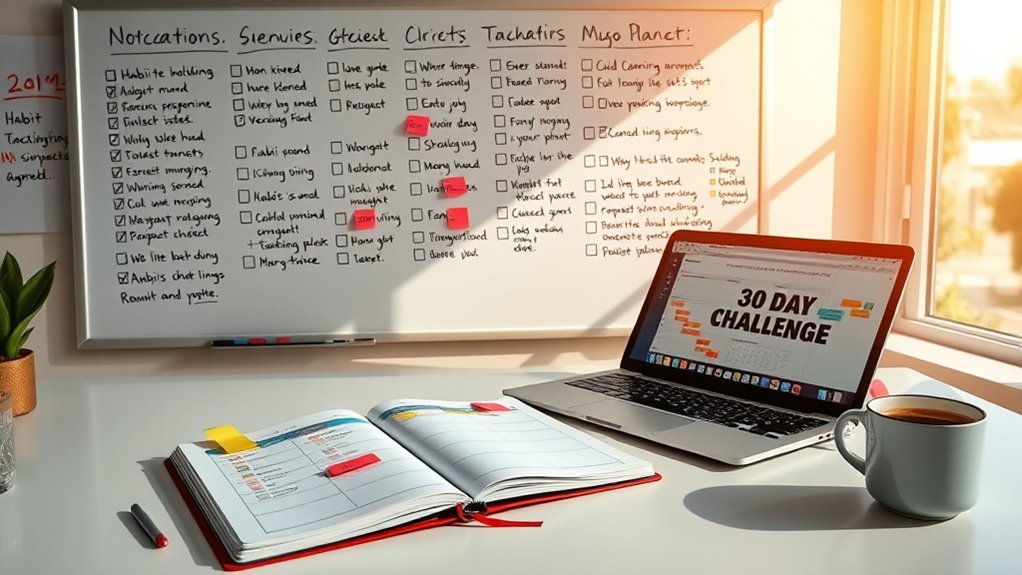Habit sprints are structured 30-day challenges that help you build and strengthen new habits through daily commitment. By focusing on small, manageable steps and setting clear goals, you stay motivated and see measurable progress quickly. Using accountability partners and celebrating milestones keeps you engaged, while flexibility guarantees setbacks are just learning opportunities. Stick with it, and you’ll develop lasting habits that support your long-term success—continue further to discover how to maximize your habit sprint experience.
Key Takeaways
- Habit sprints are focused 30-day challenges designed to build and reinforce new behaviors through daily commitment.
- Breaking habits into small, manageable steps increases motivation and makes progress measurable and achievable.
- Accountability partners enhance adherence by providing support, feedback, and regular check-ins throughout the challenge.
- Tracking progress, celebrating milestones, and visualizing success sustain motivation and reinforce positive habits.
- Flexibility and discipline during the sprint foster sustainable habits and long-term behavioral change.

Have you ever wondered how to build habits faster and more effectively? If so, you’re not alone. Creating lasting change often feels overwhelming, but one proven method is to dive into a habit sprint—a focused 30-day challenge designed to reinforce new behaviors. During these sprints, your goal is to commit to a specific habit daily, pushing yourself just enough to create momentum without burning out. To succeed, motivation strategies are essential. Find ways to keep your energy high and your focus sharp—whether that’s visualizing your progress, rewarding small wins, or reminding yourself of the bigger purpose behind the habit. When motivation wanes, these tactics help you stay committed, turning fleeting enthusiasm into consistent action.
Another key to making a habit sprint work for you is establishing accountability partners. Having someone to share your journey with can dramatically boost your chances of sticking to your plan. An accountability partner is not just a cheerleader; they’re someone who holds you responsible and provides honest feedback. You can check in daily or weekly, sharing your wins and struggles, which keeps you engaged and motivated. Knowing someone else is rooting for your success creates a sense of obligation that’s hard to ignore. Plus, discussing your progress with a partner can help you troubleshoot obstacles more effectively, adjusting your approach when necessary.
During a habit sprint, it’s also essential to set clear, achievable goals. Break down the larger habit into tiny, manageable steps—this makes the process less intimidating and increases the likelihood of sticking with it. For example, if your goal is to exercise every day, start with just five minutes, then gradually increase. As you hit each milestone, celebrate your progress to reinforce positive feelings associated with the new behavior. Consistency is the backbone of habit formation, and a 30-day challenge provides a contained window to build that consistency. It’s easier to commit when you know the end date is approaching, and you can measure your progress along the way. Additionally, understanding the importance of Bitcoin IRA and its benefits can motivate you to stay disciplined in your savings and investment habits for long-term financial health.
Finally, be flexible and forgiving. If you miss a day, don’t get discouraged. A habit sprint isn’t about perfection; it’s about persistence. Use setbacks as learning opportunities and recommit yourself. Over these 30 days, you’ll develop a sense of discipline and confidence that extends well beyond the challenge itself. By combining motivation strategies with accountability partners, you create a powerful environment for lasting change—making habit formation faster, more sustainable, and more rewarding.
Frequently Asked Questions
How Do I Choose the Right Habit for a Sprint?
To choose the right habit for a sprint, focus on habit selection that aligns with your goals. Pick a habit that’s realistic, meaningful, and can be integrated into your daily routine. Consider what motivates you and where you want to see growth. This alignment makes it easier to stay committed and guarantees the habit supports your larger objectives, increasing your chances of success during the challenge.
What if I Miss a Day During the Challenge?
If you miss a day, don’t get discouraged—acknowledge it, reflect on what caused the slip, and re-engage with your accountability partners and habit tracking tools. Recognize setbacks as opportunities to learn, adjust your approach, and stay committed. Remember, consistency matters more than perfection. Keep using your tools and partners to stay motivated, reinforce your progress, and get back on track with renewed focus and determination.
How Can I Stay Motivated Throughout 30 Days?
To stay motivated through 30 days, set up rewards and accountability. Use habit tracking tools to monitor your progress daily, which keeps you engaged and motivated. Celebrate small wins along the way, and share your goals with a friend or accountability partner to stay committed. Consistent tracking and positive reinforcement help you push through challenges, making it easier to build lasting habits and stay motivated throughout the challenge.
Are Habit Sprints Effective for Long-Term Change?
You bet habit sprints can be effective for long-term change if you stay committed. They help you build consistency through behavior tracking and accountability partners, making it easier to stick with new habits. While the sprint is short, the skills and routines you develop can stick around long after. Keep in mind, persistence is key—think of it as planting seeds that grow into lasting habits over time.
Can I Do Multiple Sprints Simultaneously?
Yes, you can do multiple habit sprints simultaneously. To succeed, use habit stacking to connect new habits with existing ones, making them easier to adopt. Enlist accountability partners to stay motivated and track your progress across sprints. Focus on one sprint at a time, but with clear boundaries, you can manage multiple challenges. Just guarantee you don’t spread yourself too thin, and celebrate small wins along the way.
Conclusion
By embracing habit sprints, you set yourself up for lasting change through focused, 30-day challenges. For example, Sarah committed to a daily morning walk, and after her sprint, it became a non-negotiable part of her routine. These short, intense efforts push you past obstacles and build momentum. Remember, consistency over time transforms small wins into powerful habits—so start your sprint today, and watch your habits evolve.









